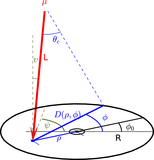Using Muon Rings for the Calibration of the Cherenkov Telescope Array: A Systematic Review of the Method and Its Potential Accuracy
Abstract
The analysis of ring images produced by muons in an Imaging Atmospheric Cherenkov Telescope (IACT) provides a powerful and precise method to calibrate the IACT optical throughput and monitor its optical point-spread function (PSF). First proposed by the Whipple Collaboration in the early 1990s, this method has been refined by the so-called second generation of IACT experiments: H.E.S.S., MAGIC, and VERITAS. We review here the progress made with these instruments and investigate the applicability of the method as the primary throughput calibration method for the different telescope types forming the future Cherenkov Telescope Array (CTA). We find several additional systematic effects not yet taken into account by previous authors and propose several new analytical methods to include these in the analysis. Slight modifications in hardware and analysis need to be made to ensure that such a calibration works as accurately as required for the CTA. We derive analytic estimates for the expected muon data rates for optical throughput calibration, camera pixel flat-fielding, and monitoring of the optical PSF. The achievable statistical and systematic uncertainties of the method are also assessed.
- Publication:
-
The Astrophysical Journal Supplement Series
- Pub Date:
- July 2019
- DOI:
- 10.3847/1538-4365/ab2123
- arXiv:
- arXiv:1907.04375
- Bibcode:
- 2019ApJS..243...11G
- Keywords:
-
- astroparticle physics;
- atmospheric effects;
- gamma rays: general;
- methods: data analysis;
- telescopes;
- Astrophysics - Instrumentation and Methods for Astrophysics
- E-Print:
- The Astrophysical Journal Supplement Series 243 (1) p. 11, 2019
